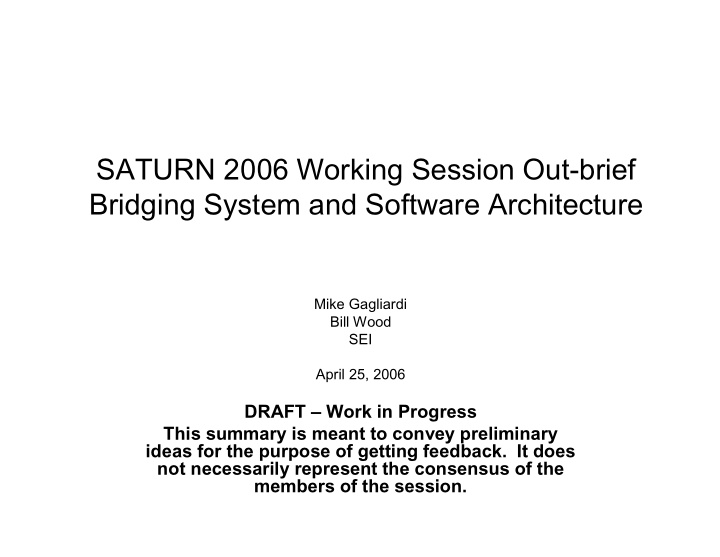



SATURN 2006 Working Session Out-brief Bridging System and Software Architecture Mike Gagliardi Bill Wood SEI April 25, 2006 DRAFT – Work in Progress This summary is meant to convey preliminary ideas for the purpose of getting feedback. It does not necessarily represent the consensus of the members of the session.
Attendees Name Organization Name Organization Mike Gagliardi SEI Rolf Siegers Raytheon Bill Wood SEI Don O’Connell Boeing Amine Chigani Virginia Tech Jeffery Kertis Bettis.gov David Mason US ARMY – CECOM SEC Dave Zubrow SEI Chi-Fang Chen Boeing Bob Krut SEI Rick Kazman SEI Brian Boucier Northrop-Grumman John Bergey SEI Ibrahim Habli CS.York.ac.uk Richard Anderson US ARMY Rob Wojcik SEI Jack Li US ARMY – CECOM SED Tim Morrow SEI Ron Koontz Boeing Nanette Brown Pitney-Bowes Bob Ellison SEI Daniel Pipitone SEI
Why is this important? Software intensive systems often suffer severe integration and operational/behavioral problems due to lack of consistency between the system and software architectures in addressing system quality attributes. Oftentimes resulting in costly re-architecting/re-design efforts and operational failures. This significantly impacts system cost, schedule and mission effectiveness.
Current State of Practice - 1 Technical – 1 • Quality Attribute (QA) requirements and specifications – Underspecified quality attribute requirements – Difficult to identify requirements and quality attributes omissions at the system level. • System architecture representations, analysis techniques, tactics, etc. – Component relationships at the system architecture level don’t have the robustness that occurs at the software level. – Lack of description of tactics at the system level for many QAs. – Lack of analytical support in many instances for QAs – No real techniques are available to look at quality attributes beyond the “well known.” – Systems architecture = system hardware block diagrams. Little notion of multiple system views (h/w maintainability, sustainability, etc) – DoDAF doesn't incorporate software concerns. Level of abstractions hurt the communication.
Current State of Practice - 2 Technical - 2 • Metrics – Lack of metrics about other important quality attributes. Increases difficulty in reasoning about these QA’s. • Common semantics – No common language, information models between system and software groups. (Have software people attend system design meetings – cross pollination.) – System architects understand quality attributes but in different terminology • Architecturally significant scenarios – Software is growing towards scenario based but this creates a bigger disconnect with some system folks. – Mission threads are a good starting point for system scenarios (sustainment, availability, performance) – Used scenario templates in system fault tree analysis activities.
Current State of Practice - 3 Process • System architecture level decisions often pushed down to lower software architecture levels • Lack of communication between system and software groups. • System architecture the result of a water fall process with functional decomposition • System architecture folks don’t fully understand/address all of the quality attributes. • Early and often integration and test is what saves them, but this may not fully scale up. • System architecture typically defined before making hardware/software trade-offs. Programmatic • Time and cost constraints make it difficult to get to the Quality Attributes. • Customers drive decision making process. Need architecture centric acquisition strategies. • Lack of ROI data impacts level of commitment and ability to make the sales pitch to management. • Pressure to allow prototypes to become products. • System engineering (and acquisition) community lack of awareness of QAW and ATAM’s. • System Engineers/Architects need to be trained and added to ATAM evaluation teams Organizational/Cultural • Separation of systems and software groups often occurs. • Large software groups (5X) compared to system groups. • No real system architecting team. • Lack of respect between the system and software group. Parallel learning experiences create different cultures. • Post mortem activities are the current means for improvement, but rarely get applied.
Technical Gaps and Issues • Gaps – Quality attribute requirements and specifications – System architecture representations, analysis techniques, tactics, etc – Quality attribute metrics – Common semantics – System scenarios • Issues – Should architecture work be centralized to all of the work that goes on for System of Systems (SoS) development? Strict, centralized system of system architect/architecture concept in question in this context. – Can ATAM be moved into the system area? Concerned about scale, decomposition, scenario/mission thread, schedule and other issues – SOA and web services impacts upon architecture and vice-versa are not well-understood. – Need to think about intersystem policies as the next higher level of abstraction. However, technology may be moving too fast to cover policies – Open source impact.
Recommendations (developed by SEI) • Near-Term – Collaborate with external organizations to understand their needs and any extensions to QAW, ATAM, etc for System Architecture. • Identify necessary extensions to existing SAT methodologies. • Initiate Pilots and Case Studies with External Collaborators – Interview individual participants – Put system engineers/architects through the SAT curriculum and follow-up. • Long-Term – Active participation in the following to include QA concerns: • INCOSE to gain more insight and influence their architecture framework activities. • Sys ML standardization and Quality Attribute UML extensions. • DoDAF, OMG, TOGAF, etc. – Describe tactics, patterns, etc for the remaining important QAs and at the system level. Collaboration with external organizations is necessary. – System Scenarios using Mission Threads are a good starting point: • Augment for all important QAs • Transform into software specific scenarios • Collaboration with external organizations is necessary. Pilot activities needed. – Investigate how SOA contributes/impacts operational to s/w transformations – Collaborate with external organizations and SEMA regarding QA metrics. – Leverage the academic community to begin the process of getting methodologies such as QAW and ATAM into the systems engineering process. – Figure out what to do about addressing common semantics (technical and cultural issue) – Investigate System of Systems architecture role, activities, etc… based on a more decentralized approach at the SoS level.
Recommend
More recommend